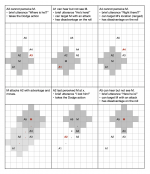Stealth is a complex skill. The rules can be found in the Player’s Handbook, largely on page 177. On the surface, it seems simple: it is a Dexterity (Stealth) check opposed by a Wisdom (Perception) check. But, there is more to it than that.
This is the part of a weekly series of articles by a team of designers answering D&D questions for beginners. Feel free to discuss the article and add your insights or comments!
So let’s break it down step by step. Using stealth generally means using the Hide action. Hiding is a 4 step process:

While Hidden
When you are hidden (which means you have used the Hide action and a creature has not noticed you with passive or active perception):
You remain hidden until you are discovered, you stop hiding, circumstances no longer allow you to hide, or you make a noise or otherwise alert others to your presence.
You do not need to continually use the Hide action every round to remain hidden, but you will need to use it again to hide once you become detected or stop hiding (this could be complex to track, as being hidden is relative to each creature).
When Can I Hide?
According to the Player’s Handbook, you “can’t hide from a creature that can see you clearly”. The complicating factor is the line "The DM decides when circumstances are appropriate for hiding”.
Be sure to discuss with your DM how they intend to interpret when a creature can and cannot see you clearly.
This is the part of a weekly series of articles by a team of designers answering D&D questions for beginners. Feel free to discuss the article and add your insights or comments!
So let’s break it down step by step. Using stealth generally means using the Hide action. Hiding is a 4 step process:
- Are you sufficiently obscured from the creatures you're hiding from?
- Use Hide action; this could be a bonus action if you have certain abilities, like the rogue’s Cunning Action or the Ranger’s Vanish.
- Compare Dexterity (Stealth) check to the passive perception scores of any creature you are hiding from and against any active Wisdom (perception) checks to search for you
- While you remain hidden, use the same Dexterity (Stealth) result until you are detected or are no longer hiding.
While Hidden
When you are hidden (which means you have used the Hide action and a creature has not noticed you with passive or active perception):
- You have advantage on attack rolls against creatures that can’t see you.
- When you make your attack, though, you reveal your position and are no longer hidden, whether the attack hits or misses.
- If a creature tries to attack you while you are hidden (and is able to guess the space you are in), it makes its attack roll with disadvantage.
You remain hidden until you are discovered, you stop hiding, circumstances no longer allow you to hide, or you make a noise or otherwise alert others to your presence.
You do not need to continually use the Hide action every round to remain hidden, but you will need to use it again to hide once you become detected or stop hiding (this could be complex to track, as being hidden is relative to each creature).
When Can I Hide?
According to the Player’s Handbook, you “can’t hide from a creature that can see you clearly”. The complicating factor is the line "The DM decides when circumstances are appropriate for hiding”.
- The book reminds DMs that they might allow a player character to sneak up on a distracted creature, even leaving their concealment to do so, if circumstances allow it.
- It goes on to say "An invisible creature can always try to hide", noting that being unseen does not mean you are undetected.
- The Player's Handbook reminds us that the "Lightly obscured' and "heavily obscured" lighting affect what one can see. Being lightly obscured imposes a -5 penalty on Wisdom (Perception) checks that rely on sight, while being heavily obscured effectively blinds creatures to things in the obscured area and makes Wisdom (Perception) checks that rely on sight automatically fail.
- We know that being invisible counts. Being invisible makes one heavily obscured "for the purposes of hiding", so heavily obscured also counts.
- Full cover is not mentioned, but since it fully blocks line of sight, it is safe to assume full cover for an opaque object would be sufficient to hide behind.
- The skulker feat allows you to try to hide when you are lightly obscured" implying you couldn't otherwise do this.
- Wood Elves have the mask of the wild ability that lets them use the hide action "when you are only lightly obscured by foliage, heavy rain, falling snow, mist, and other natural phenomena''.
- Lightfoot halflings have the naturally stealthy ability, which lets them hide "even when you are obscured only by a creature that is at least one size larger than you".
Be sure to discuss with your DM how they intend to interpret when a creature can and cannot see you clearly.




